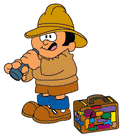

Goals:
1. Students will understand that there are a variety of sources toblame for the pollution of chemicals and other toxins in our oceans.
2. Students will understand that many of the toxins in our oceans come from household products.
3. Students will be able to recognize hazardous materials in their homes.
4. Students will understand the labeling system of chemicals and other household products.
Resources:
1. http://www.epa.gov, The United States Environmental ProtectionAgencies Home Page.
2. Materials
a. An assortment of labeled empty containers of potentially hazardous household products collected by the teacher,
students, and parents. (i.e. automotive products, cleaners, polishers, deodorizers, pesticides, paint products).
b. Activity sheet for students household products survey.
c. Hazardous Information Worksheet (what exactly is on the hazardous products labels).
Time:
Lesson will take 3 to 4 hours.
Procedure:
Background Information-
Waste is being supplied to our water systems at an vast rate. Through toilets and storm drains, pollution and contaminants enter our local water systems and oceans. Waste enters our water systems by both illegal and legal dumping of garbage by businesses and individual citizens of our society. We are polluting our own water supplies with many items that are thrown away and flushed down the toilet into our rivers, lakes, and oceans. These toxins destroy marine life and kill existing ecosystems in our lakes, rivers, and oceans.
Hazardous household products are products purchased for use in the home. These products contain ingredients that, because of their chemical properties, have the potential to harm people and the environment. Even though these products are easily purchased, they can still be harmful to the environment, to yourself, and your family. Many household products contain chemicals that are poisonous, corrosive, flammable, and chemically reactive. These products are reasonably safe (when used "as directed.") Improper disposal of these products can endanger the health of your family and the environment.
Federal law requires that most hazardous household products
include specific types of information about the product on their labels. The Federal Insecticide, Fungicide and Rodenticide Act (FIFRA) regulates labeling of products that contain pesticides. The Federal Hazardous Substance Act (FHSA) regulates labeling of all other hazardous products.
Most product labels tend to advertise the product's ability to take care of the job in which you purchased the product, rather than emphasize public safety. As consumers, we must know what to look for and how to read a hazardous products label effectively.
There are certain signal words on product labels that can give an individual a general indication of the level of its toxicity, (the lethal dose of the product.) "Danger Poison," the most lethal type. Drinking a few drops to 1 teaspoon of this product will kill the average person. "Warning," drinking 1 teaspoon to 1 ounce of this product will kill the average person. "Caution," drinking over 1 ounce of the product will kill the average person.
Step 1- Introduce the hazardous labeling system used in our country.
Step 2- Have the students use the Hazardous Product Information Worksheet and examine the empty household product containers to examine what kind of information is on the products labels.
Step 3- Have the students do a home survey or an in-store survey listing the potentially dangerous products to our water systems in their households or that can be purchased for their household.
Step 4- Have students record on their worksheets all the products in their household (or some of which are found at a store) that are labeled dangerous to the environment.
Step 5- Have students choose two items from their assignment sheet and investigate the proper disposal of that product.
Assessment:
1. The students will write a personal response on what they learned while doing their household survey. Response will be graded on completion.
2. The students will demonstrate their ability to read product labels and identify hazardous products by completing the "Hazardous Information Worksheet" and "Survey of Household Products" worksheet.
3. Students will demonstrate their knowledge on the disposal of hazardous products in their home. This can be done by the teacher's choice of writing a one page essay or by presenting information to the class. Students will be assessed in accordance with "Writing Rubric" or "Presentation Rubric."
Curricular Strands and Major Concepts:
1. Language Arts- reading and writing about hazardous products discovered in their home.
2. Science- poisonous, toxic, flammable reactive materials, and chemical properties which make products hazardous.
3. Social Studies- federal laws dealing with labeling of hazardous products.
Possible Extensions:
1. Investigate environmentally safe, biodegradable household products that are as effective as dangerous polluting products.
2. Create possible solutions to the large amount of hazardous products used, along with ideas focused on recycling of such materials.
Bibliography:
California Integrated Waste Management Board. A Consumer Guide to Safer Alternatives To Hazardous Household Products, Part 2. April 1992.